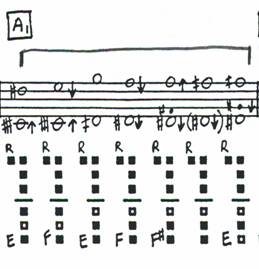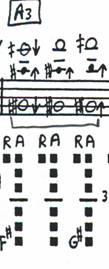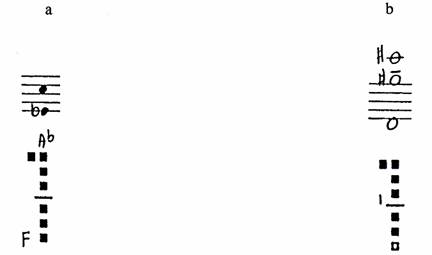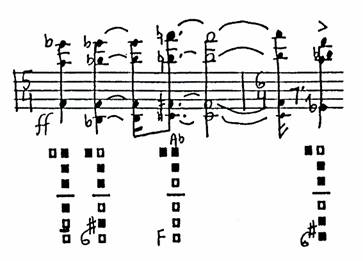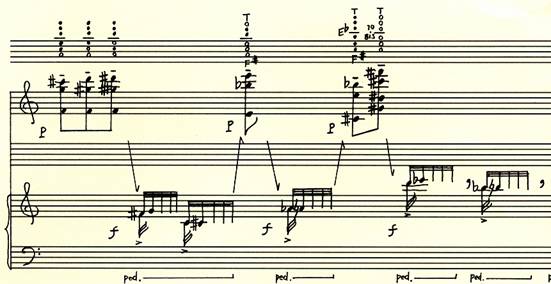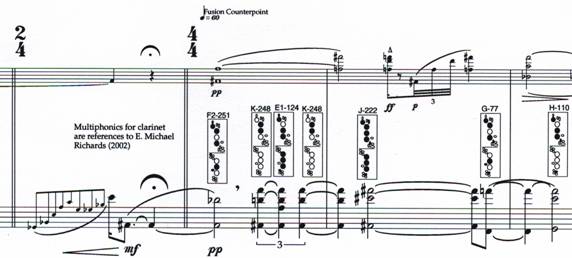| The Clarinet of the Twenty-First Century - E. Michael Richards |
CHAPTER 3 - Multiple Sounds
Multiphonic Sequences
A number of multiphonic sequences are quite easy to produce in legato articulation. In most cases, the multiphonics in the sequence may be played in any order (indicated here). Some examples are given below (with indications of fastest possible tempo) – more are available on The Clarinet of the Twenty-First Century website ( http://www.research. umbc.edu/~emrich/multiphonic sequences.html ).
• Moderate tempo; any order (click on music for mp3)
2) any order [A3] (click on music for mp3)
Richard Boulanger, an American composer from Boston, also writes an effective sequence of multiple sounds in Construction #1 for Clarinet and Electronics. The top pitches relate to the melodic cell from which the work is generated (Example #41).
Example #41 (click on music for mp3)
Richard Boulanger CONSTRUCTION #1
All Rights Reserved
Used by permission from the composer
Yuasa creates appropriate musical moods through the use of sound characteristics of the following multiphonics within a phrase: the gentle qualities of #50a serve as a relaxed phrase ending; the variety of dynamic capabilities of #50b permit its use as part of the fpp thematic germ throughout the work (Example #50).
Example #50 (click on music for mp3)
Yuasa also makes very effective use of thick, distorted multiphonics at the climax of the work.
Example #51 (click on music for mp3)
Joji Yuasa CLARINET SOLITUDE
Copyright 1983 by Schott Japan
All Rights Reserved
Used by permission of European American Music
Distributors Corporation, sole U.S. and Canadian agent
for Schott Japan
In Distraction for clarinet and piano, by Masataka Matsuo, balanced soft multiphonics are interrupted by loud repeated notes in the piano.
Example #53 (click on music for mp3)
Bill Kleinsasser utilizes balanced multiphonics in numerous contexts in Smooth Wood, Flash Metal (2003) for clarinet, flute, and interactive computer (written for E. Michael Richards and Lisa Cella).
The composer writes:
The noticeable differences between interesting objects offer engagement with the particularities of the objects themselves and also the less obvious offerings provided by the implied relationships between the objects. This work offers a three-fold expression of this idea playing out on many levels with the interplay and juxtaposition of musical differences forming the compositional basis of the work. The piece is in three large sections: an extended flute solo which evolves into a duet with the computer, a duet with flute and clarinet that is augmented by computer transformation, and a clarinet solo which forms its own context through computer transformation of the live performance. The clarinet solo is based on alternation of spectral focus and diffusion. The duet combines the flute and clarinet alternations with its own metaphor of entwining and fusion. The nature of the flute's acoustic character, how it differs from the clarinet, how the two can combine and intersect, and how these differences can be projected and transformed through the computer's particular idiom, are examples of how objects and relationships permeate this music. The computer music, developed by the composer using Max/MSP software, is the result of real-time processing of music played by the flute and clarinet during the performance. In this way the computer can be considered analogous to fluid, aware architecture – variably resonating, diffusing, echoing, filtering, and reflecting what the acoustic instruments play.
The example below occurs at the beginning of the middle section of the music – the clarinet and flute multiphonics intersect closely, sharing many of the same pitches, but a number of acoustic beats result from the blend.
Example #57 (click on music for mp3)
for information on how to see/hear more musical examples of multiphonic sequences, click here
|
||
